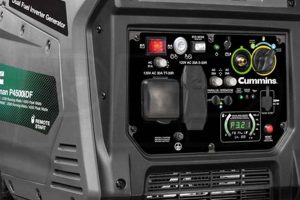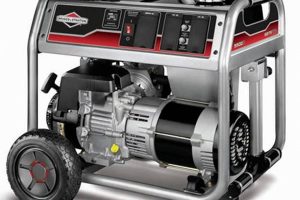The runtime of a typical portable generator depends on a complex interplay of factors, including the generator’s fuel capacity, the load placed upon it, and the efficiency of its engine. For example, a generator with a large fuel tank running a small refrigerator will operate significantly longer than the same generator powering multiple appliances simultaneously. Understanding the anticipated runtime is essential for effective power management.
Predicting operational duration facilitates preparedness in various situations, from planned outdoor events and construction projects to emergency power outages caused by natural disasters. Historically, generators offered limited runtime estimates, but modern advancements in fuel efficiency and power management systems now provide greater predictability and control, empowering users to plan effectively. This enhanced control translates into improved resource management and reduced operational costs.
This article delves into the key determinants of generator runtime, exploring the influence of factors like fuel type, engine size, and load demands. It will further examine strategies for maximizing efficiency and extending operational duration, empowering users to optimize their generator’s performance.
Tips for Optimizing Portable Generator Runtime
Maximizing the operational duration of a portable generator involves careful consideration of several factors, from fuel selection to load management. The following tips provide practical guidance for extending runtime and ensuring efficient power delivery.
Tip 1: Calculate Power Requirements: Accurately assess the wattage required to power the intended devices. Operating the generator significantly below its rated capacity improves fuel efficiency and extends runtime. Overloading the generator, conversely, leads to decreased efficiency and potential damage.
Tip 2: Utilize the Economy Mode (if available): Many modern generators feature an “eco” or economy mode. This setting adjusts the engine speed based on the current load, reducing fuel consumption when demand is low.
Tip 3: Perform Regular Maintenance: Routine maintenance, including oil changes, air filter cleaning, and spark plug replacements, ensures optimal engine performance and contributes to efficient fuel utilization.
Tip 4: Choose the Right Fuel: Use the fuel type recommended by the manufacturer. Storing fuel correctly and avoiding stale fuel is crucial for maintaining engine health and maximizing operational efficiency.
Tip 5: Manage Load Strategically: Prioritize essential devices and avoid running unnecessary appliances simultaneously. Staggering usage can significantly extend the generator’s runtime.
Tip 6: Consider Parallel Operation (if supported): For extended power needs, using two smaller generators in parallel can be more efficient than relying on a single large unit. This approach also offers redundancy in case one generator fails.
Tip 7: Monitor Fuel Consumption: Regularly check the fuel level to anticipate refueling needs and avoid unexpected shutdowns. Tracking fuel consumption can also provide insights into usage patterns and identify areas for improvement.
By implementing these strategies, users can significantly extend the runtime of their portable generators, ensuring reliable power delivery while minimizing fuel consumption and operational costs.
These practical tips provide a solid foundation for effectively managing power resources. The subsequent conclusion will reiterate the importance of these strategies in various applications, emphasizing the broader benefits of efficient generator operation.
1. Fuel Capacity
Fuel capacity plays a direct and crucial role in determining the runtime of a portable generator. The size of the fuel tank dictates the volume of fuel available for combustion, thus directly influencing the duration of operation before refueling is necessary. A larger fuel tank allows for extended operation, while a smaller tank necessitates more frequent refueling. This relationship is fundamental to understanding and predicting generator runtime. For example, a generator with a 10-gallon fuel tank will, under the same load and operating conditions, run significantly longer than a generator with a 5-gallon tank. This becomes particularly critical during extended power outages or in remote locations where refueling may be difficult or impossible.
The practical significance of understanding the fuel capacity-runtime relationship is paramount for effective power planning. Accurately estimating required runtime and selecting a generator with adequate fuel capacity are crucial for ensuring uninterrupted power supply. In disaster preparedness scenarios, where extended outages are possible, selecting a generator with ample fuel capacity may be the deciding factor in maintaining essential services. Conversely, for shorter-term applications, such as powering tools at a remote work site, a smaller, more portable generator with a smaller fuel tank may suffice. Considering the anticipated load alongside fuel capacity allows for informed decisions and prevents disruptions due to premature fuel depletion.
In conclusion, fuel capacity stands as a primary determinant of portable generator runtime. A comprehensive understanding of this relationship empowers informed generator selection and effective power management strategies. Matching fuel capacity to anticipated runtime requirements ensures reliable power delivery and avoids inconvenient or potentially hazardous interruptions. This careful consideration of fuel capacity is fundamental to maximizing the utility and effectiveness of portable generators in diverse applications.
2. Load Size
Load size, representing the cumulative power demand of connected devices, directly influences a portable generator’s runtime. This relationship stems from the fundamental principle of energy conservation: a larger load requires more energy, leading to faster fuel consumption and, consequently, a shorter runtime. The load size is typically measured in watts or kilowatts, representing the rate at which electrical energy is consumed. For example, a generator powering a single 100-watt lightbulb will operate significantly longer than the same generator powering a 1,000-watt space heater, assuming all other factors remain constant. The wattage of each device contributes to the overall load size, and managing this load is crucial for optimizing runtime.
Understanding the impact of load size on runtime is essential for effective power management. Accurately calculating the total wattage of intended devices allows for informed decisions regarding generator selection and usage strategies. Overloading a generator, exceeding its rated capacity, not only shortens runtime but also risks damaging the generator and connected appliances. Consider a scenario where a generator with a 2,000-watt capacity is used to power a refrigerator (150 watts), a few lights (100 watts total), and a microwave oven (1,000 watts). Attempting to add a 1,500-watt electric heater to this load would exceed the generator’s capacity, leading to potential overload and reduced runtime. Strategic load management, prioritizing essential devices and staggering usage, is key to maximizing operational duration.
In summary, load size is a critical determinant of portable generator runtime. Careful consideration of power demands, accurate load calculations, and strategic load management are essential for optimizing runtime and ensuring reliable power delivery. Recognizing the direct relationship between load size and runtime empowers informed decision-making and effective utilization of portable generators in various applications.
3. Engine Efficiency
Engine efficiency plays a pivotal role in determining the operational duration of a portable generator. A more efficient engine extracts a greater percentage of energy from a given volume of fuel, directly translating into extended runtime. This factor becomes particularly significant during extended operation or when fuel resupply is limited. Understanding the nuances of engine efficiency allows for informed generator selection and optimized power management.
- Combustion Efficiency:
Combustion efficiency refers to the completeness of the fuel-burning process within the engine. A higher combustion efficiency indicates that a greater proportion of the fuel’s energy is converted into usable power, minimizing waste in the form of unburnt fuel and exhaust heat. This directly extends runtime by maximizing the energy extracted from each unit of fuel. Modern generators often incorporate advanced combustion technologies to optimize this process.
- Mechanical Efficiency:
Mechanical efficiency represents the effectiveness with which the engine converts the energy released from combustion into rotational motion that drives the generator. Minimizing frictional losses within the engine components, such as pistons, bearings, and valves, contributes to higher mechanical efficiency. This ensures that more of the generated power is transferred to the electrical output, contributing to longer runtime.
- Engine Design and Technology:
Engine design and technology significantly influence overall efficiency. Factors such as engine displacement, compression ratio, and the presence of features like overhead valves (OHV) or overhead camshafts (OHC) contribute to variations in efficiency. Modern advancements, including inverter technology, further enhance efficiency by dynamically adjusting engine speed to match the load, optimizing fuel consumption and extending runtime. Inverter generators often achieve significantly longer runtimes compared to conventional generators under varying load conditions.
- Maintenance and Operating Conditions:
Regular maintenance, including clean air filters, fresh oil, and properly gapped spark plugs, ensures optimal engine performance and contributes to sustained efficiency. Operating conditions, such as ambient temperature and altitude, also influence engine performance. Higher temperatures and altitudes can reduce engine efficiency, impacting runtime. Adhering to manufacturer recommendations for maintenance and operational guidelines ensures consistent performance and maximizes potential runtime.
These facets of engine efficiency collectively influence the overall runtime of a portable generator. Understanding these elements allows for informed generator selection and operation. Prioritizing engine efficiency alongside factors like fuel capacity and load size empowers users to maximize runtime and ensure reliable power delivery in various applications.
4. Power Management
Power management plays a critical role in influencing the operational duration of portable generators. Effective power management strategies directly impact fuel consumption and, consequently, the length of time a generator can operate before requiring refueling. Understanding and implementing these strategies are crucial for maximizing runtime and ensuring efficient power delivery.
- Economy Mode/Idle Control:
Many modern generators feature an “economy” or “eco” mode, also known as idle control. This feature automatically adjusts the engine speed based on the current load. When demand is low, the engine speed reduces, minimizing fuel consumption and extending runtime. For example, if a generator is powering only a few small appliances, the economy mode will lower the engine speed compared to when it is powering multiple high-wattage devices. This dynamic adjustment contributes significantly to fuel efficiency and longer operational periods. This feature’s absence necessitates manual throttle adjustments, which may not be as precise or efficient.
- Load Prioritization and Management:
Strategic load management involves prioritizing essential devices and staggering their usage to avoid overloading the generator. This approach ensures that critical appliances receive power while maximizing runtime. For instance, during a power outage, prioritizing refrigeration over less critical devices helps conserve fuel and extends the generator’s ability to maintain essential cooling. Running high-wattage appliances like microwaves and hair dryers only when necessary further optimizes power usage. This prioritization minimizes strain on the generator and prevents premature fuel depletion.
- Voltage Regulation:
Maintaining stable voltage output is crucial for both appliance performance and generator efficiency. Voltage fluctuations can damage sensitive electronics and reduce the efficiency of the generator, leading to increased fuel consumption and shortened runtime. Modern generators often incorporate automatic voltage regulation (AVR) systems to ensure consistent voltage output regardless of load fluctuations. This stability protects connected devices and optimizes generator performance, contributing to extended runtime.
- Monitoring and Control Systems:
Advanced generators may include monitoring and control systems that provide real-time data on fuel consumption, load levels, and runtime estimations. These systems empower users to make informed decisions regarding power usage and anticipate refueling needs. Access to this data allows for proactive load management and adjustments, extending operational duration and preventing unexpected shutdowns. These systems represent a significant advancement in generator technology, enhancing both efficiency and user control.
These power management strategies, implemented individually or in combination, significantly impact a portable generator’s runtime. Understanding the interplay of these factors empowers users to optimize power consumption, extend operational duration, and ensure reliable power delivery in various applications. By actively managing power usage, users can maximize the utility of their portable generators and minimize fuel costs. This approach contributes to both operational efficiency and environmental responsibility.
5. External Factors
External factors, encompassing environmental conditions and operational context, exert a notable influence on the runtime of portable generators. While factors like fuel capacity and load size play primary roles, external conditions introduce variability that requires consideration for accurate runtime prediction and effective power management. Understanding these influences allows for proactive adjustments and ensures reliable power delivery.
- Ambient Temperature:
Ambient temperature significantly affects engine performance and, consequently, generator runtime. High temperatures can reduce engine efficiency due to increased heat stress and decreased air density. Conversely, extremely low temperatures can hinder engine starting and lubrication, also impacting efficiency. For example, a generator operating in extreme desert heat may experience a reduced runtime compared to the same generator operating in mild temperatures, even under identical load conditions. Conversely, in freezing conditions, a generator may require more fuel to maintain operation due to increased engine strain and potential fuel thickening.
- Altitude:
Altitude affects engine performance due to changes in air pressure and oxygen density. Higher altitudes result in thinner air, reducing the amount of oxygen available for combustion. This decrease in oxygen can lead to reduced engine power output and decreased fuel efficiency, impacting runtime. A generator operating at high altitudes, such as in mountainous regions, may exhibit a shorter runtime compared to operation at sea level, even with the same fuel capacity and load. This factor becomes particularly relevant for applications in high-altitude environments.
- Weather Conditions:
Beyond temperature, prevailing weather conditions like rain, snow, or high humidity can influence generator operation. Moisture can affect electrical components and potentially hinder engine performance. Protecting the generator from the elements with appropriate covers and ensuring adequate ventilation is crucial for maintaining safe and efficient operation. Operating a generator in exposed conditions during heavy rainfall or snowfall can lead to performance issues and potentially shorten its lifespan. Appropriate precautions are essential for safeguarding both the generator and its surroundings.
- Fuel Quality:
Fuel quality directly impacts engine performance and longevity. Using stale or contaminated fuel can reduce engine efficiency, leading to decreased runtime and potential engine damage. Storing fuel properly in sealed containers and using fuel stabilizers can help maintain fuel quality and ensure optimal generator performance. Employing low-quality fuel can negatively impact engine performance and may void manufacturer warranties. Prioritizing high-quality fuel contributes to both efficient operation and extended generator lifespan.
These external factors introduce a layer of complexity to predicting and managing portable generator runtime. While fuel capacity, load size, and engine efficiency remain fundamental determinants, external conditions introduce variability that requires careful consideration. Accounting for these factors allows users to anticipate potential runtime fluctuations, adjust power management strategies, and ensure reliable power delivery in diverse operational environments. Proactive consideration of external influences is essential for maximizing generator utility and effectiveness.
Frequently Asked Questions
This section addresses common inquiries regarding the operational duration of portable generators, providing concise and informative responses.
Question 1: How is generator runtime affected by altitude?
Higher altitudes, with their decreased air density, reduce engine efficiency and can shorten runtime. Consult the generator’s manual for altitude-specific operating guidelines.
Question 2: Can a generator be refueled while running?
Refueling a running generator is extremely hazardous due to the risk of fire. Always turn off the generator and allow it to cool before refueling.
Question 3: Does fuel type impact runtime?
Using the incorrect fuel type can damage the engine and significantly reduce runtime. Always adhere to the manufacturer’s recommended fuel type.
Question 4: How does ambient temperature affect generator operation?
Extreme temperatures, both high and low, can affect engine efficiency and potentially shorten runtime. Operate the generator in a well-ventilated area, protected from direct sunlight and extreme cold.
Question 5: What is the significance of a generator’s rated wattage?
The rated wattage indicates the maximum power output the generator can safely sustain. Exceeding this limit can damage the generator and connected devices. Calculate the total wattage of intended devices to ensure they are within the generator’s capacity.
Question 6: How can runtime be maximized during extended power outages?
Maximizing runtime requires strategic load management, prioritizing essential devices, utilizing economy mode (if available), and ensuring proper generator maintenance.
Understanding these factors empowers informed generator operation and ensures reliable power delivery when needed. Careful consideration of these frequently asked questions promotes safe and efficient generator usage.
The following section offers concluding remarks on the overall topic of portable generator runtime, summarizing key takeaways and providing further guidance.
Conclusion
Portable generator runtime is a critical consideration for various applications, from emergency preparedness to recreational activities. This article explored the multifaceted factors influencing operational duration, emphasizing the interplay of fuel capacity, load size, engine efficiency, power management strategies, and external environmental conditions. Each element contributes significantly to the overall runtime, and a comprehensive understanding of these factors is essential for effective power planning and utilization. Strategic load management, prioritizing essential devices and avoiding overload, emerged as a crucial strategy for maximizing operational duration. Furthermore, adhering to manufacturer recommendations for maintenance and operation ensures optimal performance and contributes to extended runtime.
Reliable access to power is often taken for granted until an outage occurs. Portable generators provide a crucial lifeline during such disruptions, and understanding their operational capabilities is paramount for preparedness. Investing in a generator represents an investment in resilience, and maximizing its operational effectiveness through informed usage and maintenance ensures reliable power delivery when needed most. Careful consideration of the factors outlined in this article empowers informed generator selection, efficient operation, and ultimately, peace of mind during unforeseen power disruptions.






